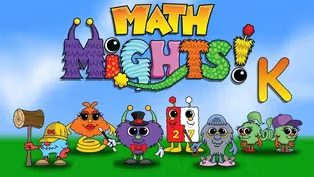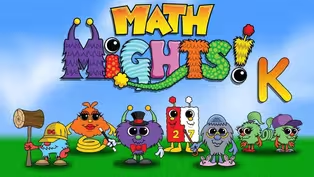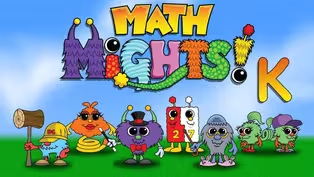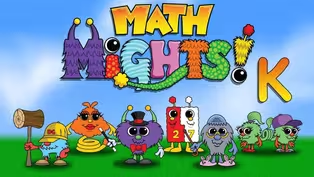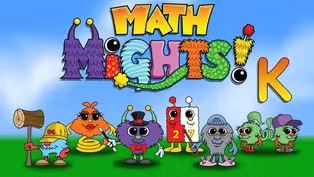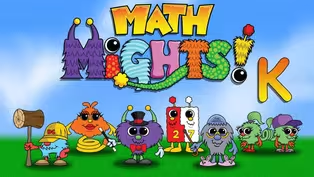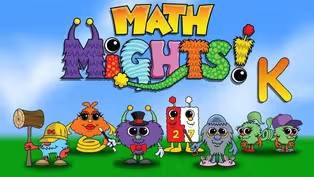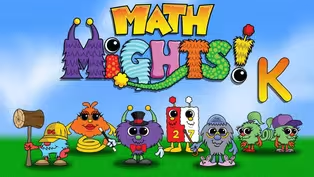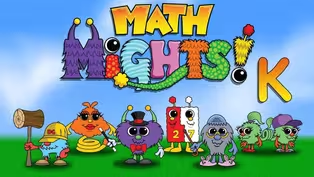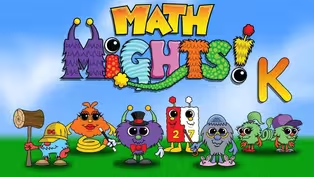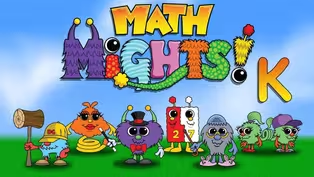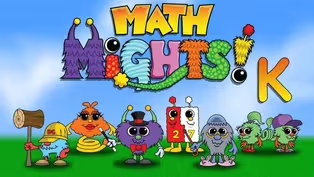Math Mights
Label Story Problems
Season 3 Episode 308 | 15m 59sVideo has Closed Captions
Join Mrs. Gray for a subtraction word problem with Professor Barble!
Join Mrs. Gray for a subtraction word problem with Professor Barble! We are going to have some fun doing word problems with 2 parts. We will learn together why labeling word problems helps us to understand what the problem is asking.
Problems playing video? | Closed Captioning Feedback
Problems playing video? | Closed Captioning Feedback
Math Mights is a local public television program presented by Detroit PBS
Math Mights
Label Story Problems
Season 3 Episode 308 | 15m 59sVideo has Closed Captions
Join Mrs. Gray for a subtraction word problem with Professor Barble! We are going to have some fun doing word problems with 2 parts. We will learn together why labeling word problems helps us to understand what the problem is asking.
Problems playing video? | Closed Captioning Feedback
How to Watch Math Mights
Math Mights is available to stream on pbs.org and the free PBS App, available on iPhone, Apple TV, Android TV, Android smartphones, Amazon Fire TV, Amazon Fire Tablet, Roku, Samsung Smart TV, and Vizio.
Providing Support for PBS.org
Learn Moreabout PBS online sponsorshipMore from This Collection
Video has Closed Captions
Join Mrs. Gray for a subtraction word problem with Porfessor Barble! (15m 52s)
Video has Closed Captions
Join Mrs. Gray for a subtraction word problem with Porfessor Barble! (15m 59s)
Video has Closed Captions
Join Mrs. Gray for a subtraction word problem with Professor Barble! (15m 59s)
Compose & Decompose Numbers to 9
Video has Closed Captions
Join Mrs. Gray for a word problem with Professor Barble! (16m 1s)
Break apart pattern block designs
Video has Closed Captions
Join Mrs. Gray for a word problem with Professor Barble! (15m 59s)
Video has Closed Captions
Join Mrs. Gray for a word problem with Professor Barble! (15m 59s)
Addition & Subtraction Expressions
Video has Closed Captions
Match fun story problems with the correct addition or subtraction expression. (16m 15s)
Video has Closed Captions
Join Mrs. Gray for a word problem with Professor Barble! (15m 59s)
Subtraction with Word Problems Part 2
Video has Closed Captions
Join Mrs. Gray & Dotson for a Numeracy Talk with My Counting Buddy Junior! (16m)
Video has Closed Captions
Join Mrs. Gray & Dotson to talk about numbers with My Counting Buddy Junior! (16m)
Addition Word Problems with Quick Draws
Video has Closed Captions
Join Mrs. Gray for Numeracy Talk with Dotson working on conservation to 10. (16m)
Providing Support for PBS.org
Learn Moreabout PBS online sponsorship(playful music) (electronic whirring and dinging) - [Children] Math Mights!
- Hi, kindergarten Math Mights!
My name's Mrs. Gray and I can't wait to do math with you today.
Today, we are going to be doing a word problem with my friend, Professor Barble.
We are also gonna be learning how to label our story problems.
Get ready!
Here comes Professor Barble.
(triumphant music) Professor Barble is an adventurer.
He always wears a thinking cap.
His thinking cap has a pole and four arrows on it.
Those arrows help remind Professor Barble that when he gets to a story problem, he needs to stop and think about which way to go with his problem.
Today, Professor Barble has a question for us.
We are gonna be using our journal template to help us work through the problem.
We're gonna go nice and slow and do each step just like Professor Barble wants us to.
Here's Professor Barble's story problem today.
There were eight bikes on the bike rack.
Three kids took their bike off the rack.
How many bikes are left on the rack?
Now, I'm gonna read it again and you're gonna repeat it after me.
Then we're gonna be adding in our chunks so we can show the different parts of information in our story.
Here we go.
There were eight bikes on the bike rack.
Can you say it with me?
There were eight bikes on the bike rack.
Now we're gonna add in the chunk.
Here's the chunk for our first piece of information.
Let's keep going.
Three kids took their bike off the rack.
Can you say it with me?
Three kids took their bike off the rack.
Now we have to add in our second chunk, because that was our second piece of information.
How many bikes are left on the rack?
Say it with me.
How many bikes are left on the rack?
Now we can add in our third piece of information.
Let's take a look at the sentence that we're gonna be using to help us figure out what we need to solve in our problem.
The sentence says, there were hmm bikes left on the rack.
Remember, when we see the line without an answer, we say hmm, because right now we don't know how many.
Now let's go to our journal template and we're gonna act it out.
There were eight bikes on the bike rack.
I'm gonna use the chips, because today we're gonna have to show the eight bikes.
If you don't have two-sided counters like me, you could use something else.
Maybe you have pennies or coins or a snack like Cheerios or Cheez-Its.
Those would work great for acting out the story problem.
There were eight bikes on the bike rack.
Help me count the bikes.
One, two, three, four, five, six, seven, eight.
Three kids took their bikes off the rack.
How could we show that on our mat?
I know, we could take them and move them off of the mat and pretend they're not there.
Let's take three off.
One, two, three.
There are the bikes that are left.
Let's see how many.
Count with me.
One, two, three, four, five.
There are five left.
Now we're gonna move over to our journal template and do our Quick Draw.
Let's draw the eight bikes.
One, two, three, four, five, six, seven, eight.
How can we show that three of the bikes are gone?
I can't grab 'em and take them off my journal template.
Do you know what we could do?
We could X them out and we'll pretend that they're gone.
Let's cross off three bikes.
One, two, three.
There are five bikes left on the rack.
Let's organize that in our 10 frame.
Here are the eight bikes.
One, two, three, four, five, six, seven, eight.
Now we have to cross out the three bikes that are gone.
One, two, three.
It shows now that we have the five bikes left.
Now let's take what we've learned and we're gonna put it into our number bond.
We are gonna show that three and five, When you put them together, it was the eight bikes that we start with.
Five and three is eight.
Let's add it in our number bond.
If I had five and three, it is eight.
Now we're gonna move to the bottom of the journal template and do the number sentence.
I know this is gonna be a subtraction problem because we're taking away three bikes.
Let's write the number sentence.
Eight subtract or take away three equals five.
Let's go back to that sentence that we had at the top of the journal.
Let's see and add in our number.
There were hmm bikes left on the rack.
We know that there was five bikes.
Let's put it into the sentence.
There were five bikes left on the rack.
Wow, kindergarten Math Mights, you worked so hard on that word problem!
Thanks for all your help.
Professor Barble would be so proud of us.
Let's take a look at our I can statement for today.
I can show what happens in story problems and solve it.
Now I have a story for you.
As I read this story, I want you to try to picture it in your head.
Here it is.
Elena is shopping at the market with her grandfather.
Elena chooses some mangos Her grandfather chooses some pineapple.
How many pieces of fruit did they choose?
Hmm.
What did that story make you wonder?
What did you notice when I told you that story?
I have some friends here that are gonna share their thoughts.
Our friend Kegan noticed that Elena and her grandfather are shopping together in the market.
Nisha noticed that they chose two different fruits to buy, but she doesn't know how many of each fruit.
I wonder what they wondered.
Kegan wondered how many pineapples and mangos each of them chose.
And our friend Nisha wondered, did they choose more pineapples or more mangos?
Hmm, those are some good thoughts.
I wonder what you thought of the story problem.
We're gonna go back to the story problem, but this time we added the numbers in.
Let's look at the problem.
Elena chose four mangos.
Her grandfather chose two pineapples.
How many pieces of fruit did they choose?
We're gonna act out this problem on our story mat.
For today, I'm going to use some linking cubes.
I'm gonna use orange to represent the mangos, and yellow to represent the pineapples.
If you don't have linking cubes, you could always use some paper.
If you took paper and just ripped it into little pieces, you could use that and pretend that those are the mangos and the pineapples.
Here are the four mangos.
One, two, three, four.
And her grandfather chose two pineapples.
One, two.
How many pieces of fruit did they choose?
Can you count them with me?
One, two, three, four, five, six.
There were six pieces of fruit.
Let's try to do our Quick Draw.
Here are the four mangos.
One, two, three, four.
And her grandfather's two pineapples.
One, two.
There were six pieces of fruit.
We want to show this in our number bond.
We're gonna show that two and four, when you put them together, it's six.
Let's do it.
Here are the four mangos and the two pineapples.
And when we put them together, there were six pieces of fruit.
Let's see if we can draw a number sentence to match.
Four plus two equals six.
I know this is an addition problem because we got more fruit.
We took the numbers and put them together, and that would make it an addition problem.
Let's take a look at how our friend Kegan and Nisha made their drawing to match the problem.
Looking at Kegan's drawing, I notice that he has four, and then he drew a line and two more.
Let's go back to my drawing and see if we can improve my drawing to show the problem.
I saw that Kegan had the four, and he separated out the two.
This makes it look a little nicer because we can clearly see the two parts for the number.
We can see the four and the two.
Let's see what Nisha did in her drawing, In Nisha's drawing, she also had the line to show the four and the two.
But I also notice that Nisha has the letter M and a letter P. What do you think that those are for?
Why would Nisha put an M at the top and a P at the top?
Hmm, I think I have an idea.
Remember, we were looking at how many mangos and pineapples there were.
Mangos starts with the letter M, and pineapple starts the letter P. Let's go back to my drawing and see if we can improve it.
What Nisha did was she had the four, and she wrote the M to show that there were four mangos.
Then over here, she had a P to show the two pineapples.
By adding those letters, we can clearly see what the numbers are talking about.
We can see the pieces, we can see the mangos, and we can see where the pineapples are.
You are doing a great job!
Thanks for helping me label that drawing to make it look more clear.
I have another story for you.
Here it is.
A bear was searching for berries in the forest.
He ate three blueberries.
He ate six raspberries.
How many berries did the bear eat?
Let's take a look at how Kegan made his drawing.
Kegan made this drawing.
Just take a look at it.
Hmm, do you see any ways that Kegan could make his drawing a little more clear?
Let's see what our friend Nisha has to say.
Nisha thinks that he could add the line to show the two parts.
That's right.
Let's go down and look more closely at Kegan's drawing.
Here is the drawing that Kegan made.
He showed the three and the six, but he didn't break them up.
So we're gonna add the line here.
That way we can clearly see that there were three blueberries and six raspberries.
I wonder if there's another way to make our drawing more clear?
Hmm, do you notice anything we could do?
I think that we should add the label.
Do you remember in the last problem, we added the M and the P to show the mangos and the pineapples.
We could do the same thing here.
We could add a B here to show that these are the three blueberries.
And we could add an R to show that this is the six raspberries.
Let's draw a number sentence that would match our problem.
The bear ate three blueberries plus six raspberries.
And that means he ate nine berries all together.
Great job, Math Mights!
We had so much fun playing that game.
Now it's your turn.
You are going to get to match drawings to different word problems.
You might need help to read some of the word problems, so you could ask someone to help read it to you.
I hope that you had a great day today with me.
We were able to do a word problem with Professor Barble.
Then we learned the importance of labeling our drawings when we do a word problem.
I can't wait for you to come back and do math with me soon.
(playful music) (cheerful whistling music) - [Boy] Sis4teachers.org.
- [Girl] Changing the way you think about math.
- [Announcer] This program is made possible with funding from the Michigan Department of Education, Governor's Education Emergency Funds, the State of Michigan, and by viewers like you.
(playful music continues)


- Home and How To

Hit the road in a classic car for a tour through Great Britain with two antiques experts.










Careers that Work

Support for PBS provided by:
Math Mights is a local public television program presented by Detroit PBS
